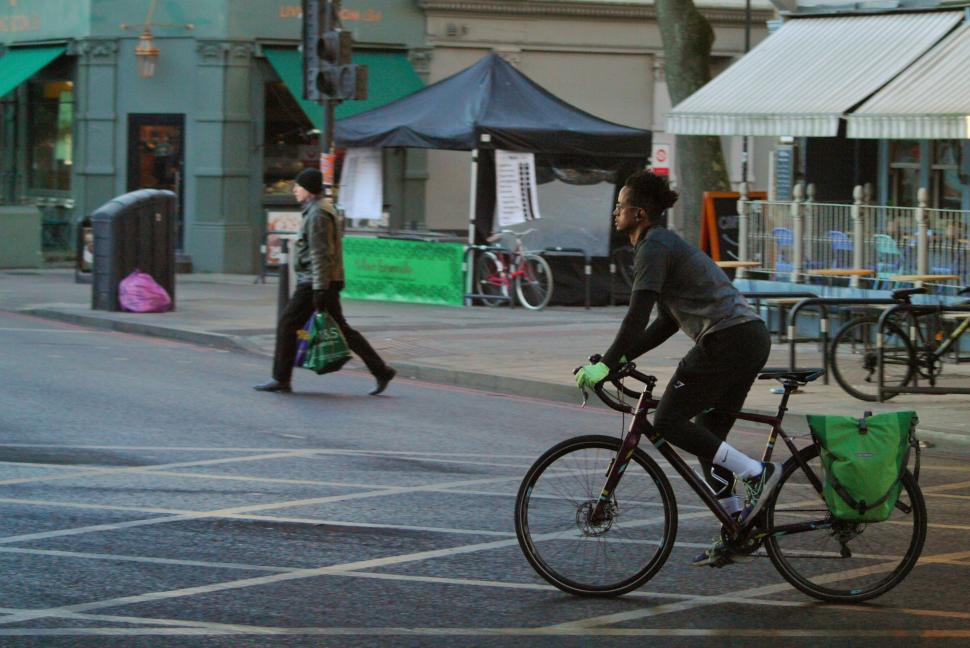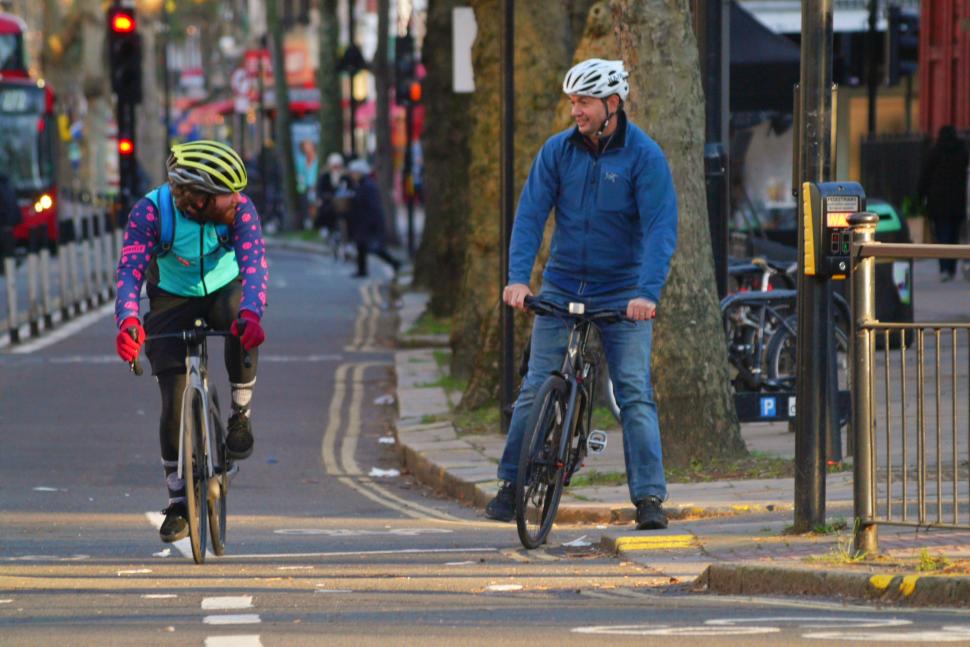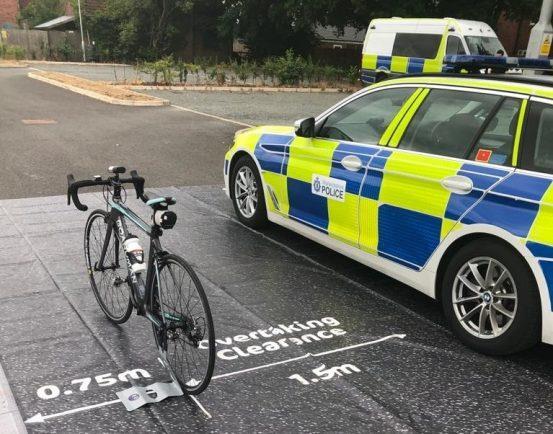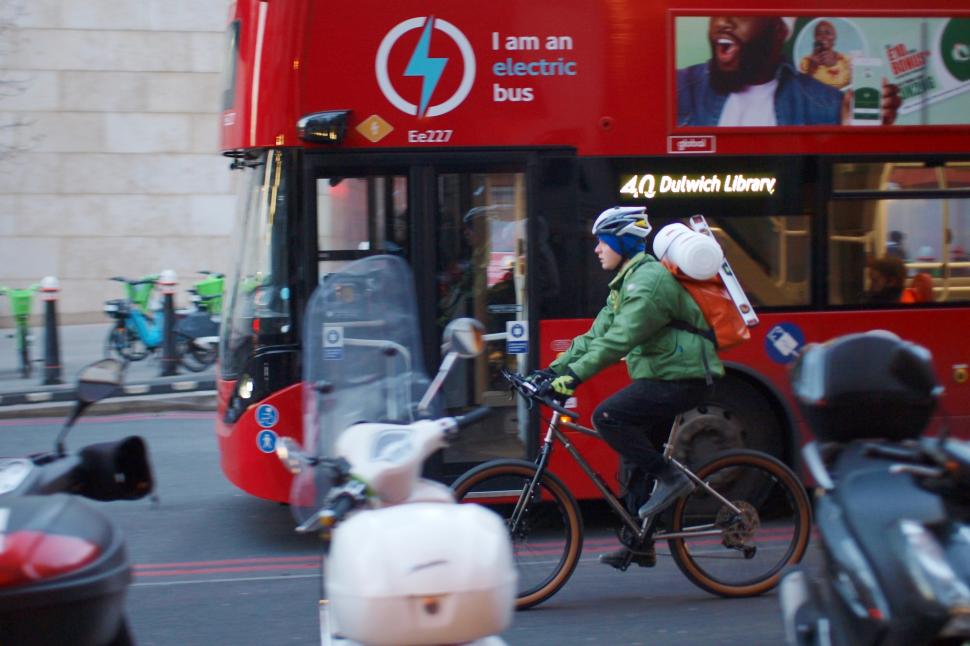- News
- Reviews
- Bikes
- Components
- Bar tape & grips
- Bottom brackets
- Brake & gear cables
- Brake & STI levers
- Brake pads & spares
- Brakes
- Cassettes & freewheels
- Chains
- Chainsets & chainrings
- Derailleurs - front
- Derailleurs - rear
- Forks
- Gear levers & shifters
- Groupsets
- Handlebars & extensions
- Headsets
- Hubs
- Inner tubes
- Pedals
- Quick releases & skewers
- Saddles
- Seatposts
- Stems
- Wheels
- Tyres
- Tubeless valves
- Accessories
- Accessories - misc
- Computer mounts
- Bags
- Bar ends
- Bike bags & cases
- Bottle cages
- Bottles
- Cameras
- Car racks
- Child seats
- Computers
- Glasses
- GPS units
- Helmets
- Lights - front
- Lights - rear
- Lights - sets
- Locks
- Mirrors
- Mudguards
- Racks
- Pumps & CO2 inflators
- Puncture kits
- Reflectives
- Smart watches
- Stands and racks
- Trailers
- Clothing
- Health, fitness and nutrition
- Tools and workshop
- Miscellaneous
- Buyers Guides
- Features
- Forum
- Recommends
- Podcast
OPINION
Changes to the Highway Code mean very little if they are not known or followed by motorists
 Cyclist in London on road bike with panniers - copyright Simon MacMichael
Cyclist in London on road bike with panniers - copyright Simon MacMichaelIn 2018 I wrote about whether the Highway Code was fit for purpose, how it should be updated and commenting on the Department for Transport’s recommended changes.
I highlighted four of the key ways in which the Highway Code could be updated for the benefit of cyclists, both to promote cycling among would-be cyclists and to improve the situation for existing cyclists.
The Highway Code has now, of course, been updated. So I thought it might be interesting to revisit this, discuss the changes that have been made to the Highway Code, and see how things on our roads should be changing.
The assumption is that we should all be aware of the changes to the Highway Code. Sadly, a few of my own recent experiences suggest that many motorists are unaware of the changes.
> One-in-four drivers still don't know correct Highway Code rule on cyclist priority
Previously I suggested The Highway Code was long overdue an overhaul, and considered the most meaningful changes that could be made for the benefit of cyclists. I suggested that the changes would send the right messages to prospective cyclists and perhaps to improve the situation for existing cyclists.
But first, let’s look at what did change:
How was the Highway Code changed?
The Highway Code was changed on 29 January 2022. A table showing the changes to The Highway Code is available here, and you can also read this comprehensive guide to the Highway Code for cyclists that takes the recent changes into account.
There is no substitute for reading the changes, but in my view the most interesting changes were as follows:
1) The introduction of a hierarchy of road users, where the most vulnerable road users are placed at the top of the hierarchy. Those in charge of vehicles that can cause the greatest harm in the event of a collision bear the greatest responsibility to take care and reduce the danger they pose to others. Prominent changes include:
- At a junction, other road users should give way to pedestrians crossing or waiting to cross a road into which or from which drivers, motorcyclists or cyclists are turning; and
- When they are turning into or out of a junction, drivers and motorcyclists should not cut across cyclists and should gave way to them. When cyclists are using a cycle lane, motorists should give way to cyclists approaching from behind and should be prepared to stop and wait for a gap in the flow of cyclists
2) The wording around recommended clothing and wearing a cycle helmet has been improved.
3) Clarification has been provided that cyclists are permitted to cycle two abreast and that it can be safer to do so, especially in larger groups.
To avoid being struck by the doors of parked cars being opened, cyclists are advised to leave at least the width of a car door or 1m of space when passing parked vehicles.
Filtering is addressed. Cyclists are described as passing slower moving or stationary traffic on the left or right. Cyclists are advised to only pass to the left (inside) of large vehicles when they are stationary or slow moving.
There is a new rule concerning road positioning. Examples are given of situations when cyclists should ride in the centre of the lane and other situations when it might be more appropriate to stay further to the left, but not in the gutter.
Specific reference is made to motorists leaving at least 1.5m when overtaking cyclists at speeds of up to 30mph and giving them more space when overtaking at higher speeds and/or in bad weather.
The Dutch Reach is specifically recommended when doors of parked vehicles.
At the risk of repeating myself, I’ll answer here a few questions about the Highway Code that are frequently asked online:
Are cyclists allowed to overtake on the inside?
When filtering, yes. The Code confirms that cyclists can pass slower moving or stationary traffic either on the right or left.
It does make some recommendations though. One for cyclists first, stating that cyclists only pass on the left of large vehicles when they’re stationary or slow moving. But there are also some other rules for motorists, stating that they should be aware of cyclists filtering when in traffic and explaining cyclists can be difficult to see in such circumstances.
How much room do you have to give a cyclist when overtaking?
Motorists should leave at least 1.5 metres when overtaking cyclists at speeds of up to 30mph, and more space when overtaking at higher speeds.
Furthermore, motorists should take extra care when overtaking all other road users at night or in bad weather.
Do cars have to wait for pedestrians?
In certain circumstances, yes.
At a junction, other road users should give way to pedestrians crossing or waiting to cross a road into which or from which drivers, motorcyclists or cyclists are turning. Pedestrian also have priority when they have already started to cross.
The Code provides further guidance to motorists who should drive ‘carefully and slowly’ when:
- needing to cross a pavement, cycle lane or cycle track; for example, to reach or leave a driveway or private access. Give way to pedestrians on the pavement and cyclists using a cycle lane or cycle track
- reversing into a side road; look all around the vehicle and give way to any pedestrians who may be crossing the road
- turning at road junctions; give way to pedestrians who are crossing or waiting to cross the road into which or from which motorists are turning
- approaching pedestrians who have started to cross the road ahead. They have priority when crossing at a junction or side road so motorists should give way
Did any of the changes discussed in my previous blog make the cut?
Generally speaking, yes. More below:
The Dutch Reach
In my previous blog I discussed the this, it’s a better way of opening a vehicle’s door by reaching across one’s body with the hand furthest from the door. This method forces the occupant of the car to turn and look behind them for cyclists before opening the door. For example, when opening the door on the right, using the left hand to open the door as it involves looking over the right shoulder, back towards any oncoming cyclists or other vehicles.
Addressing close passes
I felt that the time had come to define safe passing distances by referring to a precise distance, in metres. The police in certain regions were doing so by educating drivers as to appropriate distances. The Highway Code now states that motorists should leave at least 1.5m when overtaking a cyclist travelling at 30 mph. A greater distance should be left at higher speeds or in adverse weather.
Causative potency and victim-blaming
Generally I was advocating a move away from language that placed an emphasis on cyclists when it would be more appropriate to place the onus on motorists.
I pointed to examples within the Highway Code which unfairly placed the responsibility on cyclists e.g. to watch out for doors being opened or to be aware of traffic coming up from behind. I feel the introduction of the hierarchy is a welcome step in the right direction.
So, have things actually changed out on the roads?
I’d be interested to see whether people have noticed a difference in the last couple of years.
Personally, I haven’t, either when cycling or in the nature of personal injury claims I am instructed to pursue by injured cyclists. Mainly I think that’s because the publicity surrounding the changes was awful. It’s potentially a huge risk for cyclists and pedestrians to assume motorists are aware of the changes and they are going to give way at junctions.
It would appear that I am not alone. In a poll by Cycleplan only 18 percent of cyclists said that they felt safer at junctions, following the changes. Probably due to the uncertainty created by assuming motorists understand the changes, 12% said that they felt junctions felt more dangerous following the changes. 70% of respondents said they had not noticed a difference.
The changes themselves mean very little if they are not known or followed by motorists. A report in 2023 for Cycling UK suggested that 25% of adults knew nothing at all about the changes. Whilst only 30% of those who were aware of the updates, and drove at least once a week, could correctly identify the overtaking guidance.
Cyclists who are injured now have a more helpful Code to which to refer when alleging negligence on the part of motorists, and that’s great for legal claims; but obviously people would rather avoid collisions and injuries altogether, which is why I think vulnerable road users are reluctant to assume motorists will be aware of the changes to the Highway Code.
After taking up cycling to commute between Bristol and Bath, Mark has seen all sorts of incidents and has become a keen advocate for cycling and protecting the rights of cyclists.
Mark is now lucky enough to combine his passion for cycling with his day job as a cycling solicitor at RWK Goodman.
More Opinion
Latest Comments
- eburtthebike 35 min ago
Newspeak:...
- eburtthebike 2 hours 41 min ago
As Ranty Highwayman says, an eight minute presentation of everything that is wrong with UK highway design, starting from the premise that...
- Sredlums 3 hours 37 min ago
Except I wasn't compairing ebikes to cars like you do here, I was comparing ebikes with regular bikes, and pointing out that in the name of pedal...
- Dnnnnnn 4 hours 13 min ago
I can see you've had a look at the Inverness Tourist Board Facebook page...
- Piratepete 4 hours 23 min ago
The Police Scotland Digital Evidence Sharing Platform being rolled out will not make it any easier to report incidents, it simply allows an...
- Rendel Harris 6 hours 20 min ago
Highway Code states: ...
- open_roads 7 hours 47 min ago
It's great to see this sort of innovation but it's always worth reminding people who say helmets should be mandatory that most cycling fatalities...
- hawkinspeter 10 hours 23 min ago
I do indeed.
- Jakrayan 10 hours 32 min ago
The article states the toerags were youths, so unfortunately there probably won't be any real punishment. But at least the police are appealing for...



Add new comment
22 comments
Non-prescribed zebra crossings (just the road markings, no beacons) would encourage drivers to give priority to predestrians. They're fairly common on private land (e.g. shopping centres).
Except that very few motorists pay any attention to the ones on private land (eg. shopping centres) "cos they ain't legal, innit".
To my mind we took a backward step doing away with 1970s public information ads. I.e. Charlie says and "Meet Mike he swims like a fish" etc. Although the medium would need to expand to social media as well as TV.
I appreciate the current government would see that as nanny state and people are telepathic and will simply know the Highway code has changed.
In the 70s you had a captive audience on terrestrial TV. Now you would be lucky to hit a few million on BBC channels. You would spend vast sums to get the word out there effectively on all platforms.
As someone below has suggested. You would be better off sending letters to people. Or perhaps every 2 years anyone who is a driver needs to go online and pass a quick test on the changes to regulations.
I have noticed a significant improvement in my daily commute. Most drivers pass wide however I still keep as far left as possible.
If I notice traffic behind me I usually go on the pavement or pull over.
I'm not playing the ego game but have still had a few very close shaves.
What exactly is the 'ego game' then ?
I hope you are not referring to primary position or taking the lane at hazardous points.
Glad the commute is improving. People have different risk tolerances / behaviours that make them feel safer. For me - cycling in an urban area - there is generally "traffic behind me" so "pull over" would mean I simply wouldn't get anywhere fast.
That doesn't mean I'm blocking traffic - very often there is space for vehicles to safely overtake OR I'm going close to the speed limit (Edinburgh has a lot of 20mph) anyway.
Mostly this works perfectly well, apart from a handful of poor drivers (eg. not looking ahead / at all / speed limits not for them / no idea how wide their vehicle is) and some stand-out hooligans (memorably unpleasant).
If there *was* a tail-back behind AND me getting out of the way would help (eg. not much point when approaching a red light) AND it's safe for me to let people by I might pull to the left. Stopping and leaving the carriageway though? That would probably mean I'd gone onto the wrong road and would be reconsidering my route! (Have done that on some tours...)
What I won't be doing is just cycling on the pavement or in the gutter. The latter has various issues and the former actually increases danger to me (as well as increasing wear on bike due to all the glass, metal, gravel etc. there).
As a cyclist, I'm finding that the majority of drivers are being more polite but there's still some vindictive idiots out there; and whether the former has anything to do with the code or just a greater empathy is anyones guess.
As a pedestrian, when the code changes came in, I seemed to be given priority crossing about a 1/3 of the time but as time has progressed and folk have forgotten about/ got reuse to the might is right norm, I hardly ever get given priority crossing
I'm glad that is the case in your area.
Unfortunately, the opposite is true in the area I live. It gets worse every week. You are lucky to get a decent driver at ant time. And that doesn't matter if I'm cycling or driving. Walking is almost a no-no.
People regularly argue that the dft needed to do more advertising of the changes.
But articles about how no-one knows the rules have changed have been on every major news source - nothing the government could have done would have had higher exposure than this imho...
The solution is for people arguing they didn't know the rules had changed be required to pass a driving test with x months or lose licence until they do...
The problem with "publicising" the changes via the media - rather than official channels - is that they have completely misinterpreted the updates (either maliciously, or incompetently)
So many people who have heard of the update come out with the classic "pedestrians are allowed to just step out in front of vehicles" myth.
Even acquaintances of mine, who I consider to be fairly reasonable people, get all Kevin the teenager at the thought of the massive imposition of the changes.
People really are strange.
Could they not just send a flyer or mailer to every registered licence holder or registered keeper?
Wouldn't cost more than 25p per piece surely, maybe £20m for the entire country? Peanuts
Have you checked the price of a stamp recently? And then there's the cost of your mate with no prior experience having to set up a new company to win the contract to do the posting.
How about an email as this would be much cheaper. They must have email addresses for many as I have just received a 30 day note my MOT is due.
"Do cars have to wait for pedestrians?"
should be
"Do drivers have to wait for pedestrians?"
http://rc-rg.com
A great article and very useful. DfT have failed to promote these changes other than an update to the code. No mention of education, advertising nor similar. DfT, knowing the competence within the road user community, especially motorists, prior to 2022 update should have foreseen the need to properly inform and educate as the changes are significant. Many motorists and cyclists have had no formal training or updates since their original training and test, so potentially way out of practice and not meeting current road user behaviours, never mind the updates. Very frustrating! As a cyclist, I have been shouted at several times by motorists who so clearly have not updated their understanding whilst I have been following the new changes. It is amazing that I haven't been rear ended tbh at junctions tbh, so take care and give plenty of warning to others of your actions. Eye contact has become even more important.
Very few drivers care enough about the changes to make a difference.
The issue of roundabouts needs clarification.
When using the road, I would class the exit from a roundabout to be a left turn, therefore pedestrians and cyclists about to cross have priority, and when I am in my car, I concede priority and allow them to cross.
However... this is normally met by horns and squealing tires from the vehicle behind as they are already accelerating up to whatever speed they choose to exceed the limit at.
There is no way on earth I would consider doing that on my bike.
So ... is an exit from a roundabout classed as a left turn an subject to the changes ... or is it not?
I think that it is and it is clarified in rule 187.
Rule 187
In all cases watch out for and give plenty of room to
pedestrians who may be crossing the approach and exit roads
Interesting, my initial instict would have been no because there is no line marking a roundabout exit similar to the line marking a turn into a side road.
But of course that always comes with the caveat - "You can't drive into a human just because you think you have priority" so obviously looking where you are going is essential.
"watch out for and give plenty of room to pedestrians who may be crossing the approach and exit roads" is less of a requirement than "you should give way to pedestrians crossing or waiting to cross a road into which or from which you are turning."
As a pedestrian I would not be as assertive about crossing a roundabout exit, as a regular side road.
I would suggest that very very few people know the changes inside out on either side of this. Cyclists, pedestrians or drivers. Add to that the inate hate for cyclists and the crappy standards of driving in this country and its unsurprising not that much has changed.
Agreed. As a pedestrian, I have explained to many drivers that they should allow pedestrians to cross at junctions. But as both a cyclist and driver, I have had plenty of occasions where a pedestrian stares at me in confusion and refuses to cross when I am giving them said priority.
as both a cyclist and driver, I have had plenty of occasions where a pedestrian stares at me in confusion and refuses to cross when I am giving them said priority
Because they know that the police and the legal system don't take the Highway Code seriously, and will not penalise a driver for ploughing into a group of pedestrians exercising their 'rights' (they just stepped out in front of me, I didn't stand a chance!)